In the Women and Infants Center at UAB, patient safety is critically important. We strive to deliver effective and efficient care while protecting our patients from harm. One example of patient safety is our work surrounding healthcare-associated infections. These infections sometimes occur because of patients’ medical conditions and because medical care often requires the use of devices, treatments, and procedures that can save lives but also increase the risk of infections. Some of these infections can be prevented by ensuring that best practices are followed.
We provide measures of our performance in six major areas related to patient safety in the Women and Infants Center:
• Central Line-Associated Blood Stream Infections (CLABSI)
• Catheter Associated Urinary Tract Infections (CAUTI)
• Surgical Site Infections (SSI)
• Hand Hygiene
• Patient Falls
• Hospital acquired pressure injury (HAPI)
Central Line-Associated Blood Stream Infections (CLABSI)
Patients in the hospital often need a way to receive medication through a vein. This is performed through an intravenous (IV) catheter in the arm or a central line in the neck, chest, arm, or groin. A central line-associated blood stream infection (CLABSI) can occur when bacteria enters the body through the catheter. Hospitals have standardized steps to avoid these infections and they measure the rates of infection through Standardized Infection Ratio (SIR) to ensure these practices are followed.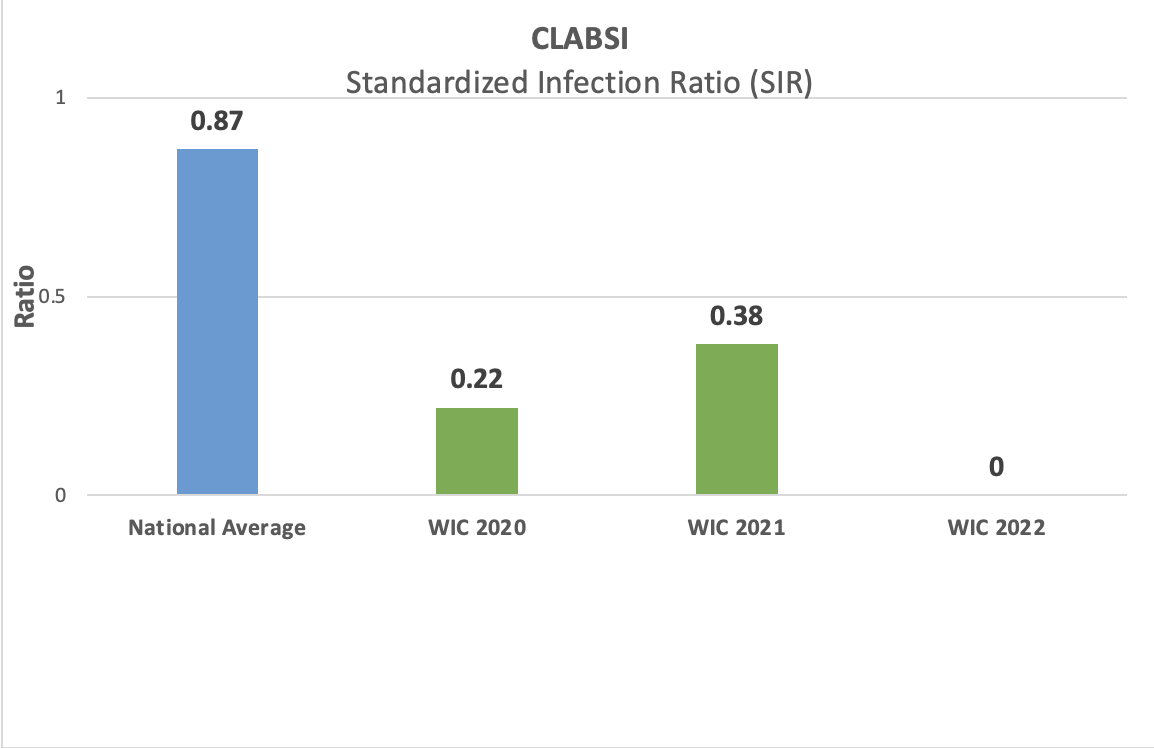

Steps our doctors, nurses, and healthcare personnel in the Women and Infants Center take to prevent a CLABSI:
- Assess patient status to ensure central line placement is medically necessary
- Identify the safest insertion site for the individual patient
- Wash their hands, wear gloves, and clean the site before inserting the catheter
- Wash their hands, wear gloves, and clean the catheter opening before using the catheter to draw blood or infuse medications
- Use a checklist to ensure all steps are followed
- Assess the individual patient need for a central line daily and remove the catheter as soon as possible
- Monitor infection rates regularly to identify any opportunities for improvement
Catheter Associated Urinary Tract Infections (CAUTI)
Patients in the hospital may need an indwelling urinary catheter inserted into their bladder to collect urine. A catheter associated urinary tract infection (CAUTI) can occur when bacteria enters the body through the catheter. Hospitals have standardized steps to avoid these infections and they measure the rates of infection through Standardized Infection Ratio (SIR) to ensure these practices are followed.
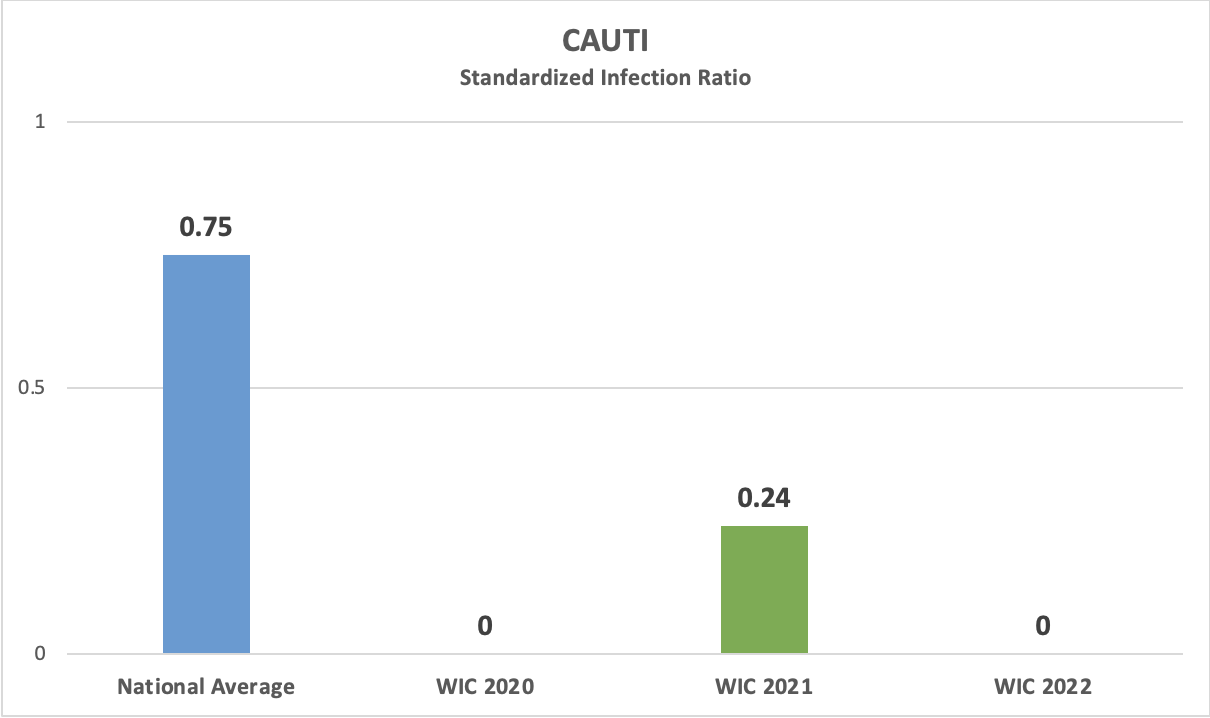

Steps our doctors, nurses, and healthcare personnel in the Women and Infants Center take to prevent a CAUTI:
- Assess patient to ensure a urinary catheter is medically necessary
- Wash their hands, wear gloves, and clean the site before inserting the catheter
- Secure the catheter to the leg and hang the collection bag below the level of the patient
- Empty the catheter on a regular basis
- Use a checklist to ensure all steps are followed
- Assess the individual patient need for urinary catheter daily and remove the catheter as soon as possible
- Monitor infection rates regularly to identify any opportunities for improvement
Surgical Site Infections (SSI)
A surgical site infection (SSI) is an infection that occurs after surgery in the part of the body where the surgery took place. Most patients who have surgery do not develop an infection. Hospitals have standardized steps to avoid surgical site infections and they measure the rates of infection through Standardized Infection Ratio (SIR) to ensure these practices are followed.
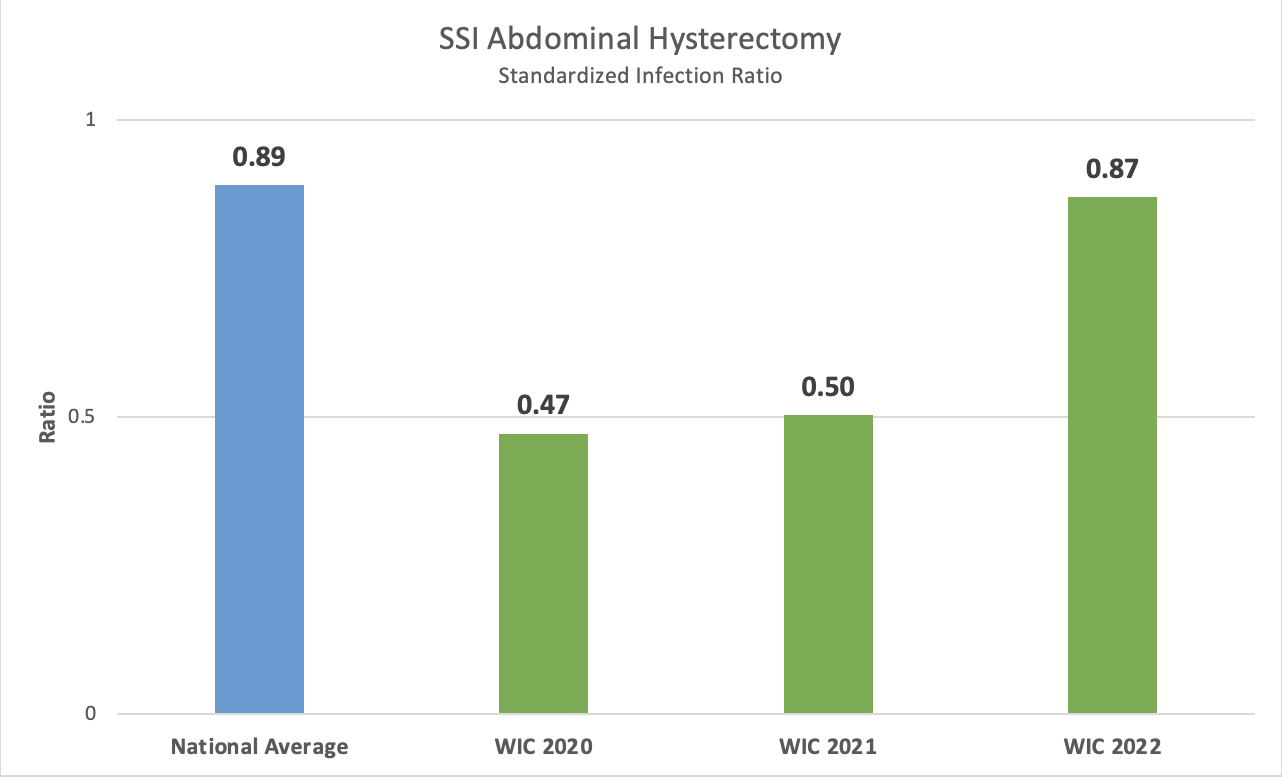

Steps our doctors, nurses, and healthcare personnel in the Women and Infants Center take to prevent a SSI:
- Wash their hands before and after caring for each patient
- Wash their hands and arms up to their elbows with an antiseptic agent before surgery
- Assess each individual patient for the need to remove hair with electric clippers at the surgical site before surgery
- Keep the operating room clean by wearing special hair covers, masks, gowns, and gloves during surgery
- Assess each individual patient for the need for antibiotics before surgery
- Clean the skin at the site of the surgery with a special soap that kills germs
- Monitor infection rates regularly to identify any opportunities for improvement
Hand Hygiene Compliance
Hand cleansing with soap and water or by using an alcohol-based hand sanitizer is the simplest and most effective way to prevent infection. Women and Infants Center staff, patients, and visitors are continuously reminded about the importance of hand hygiene. Clean hands protect everyone – patients, visitors, and staff. Hospitals measure compliance rates the nurses, doctors, and staff. Hand hygiene is reported as a percentage of compliance with hand hygiene protocols. A higher percentage is better.
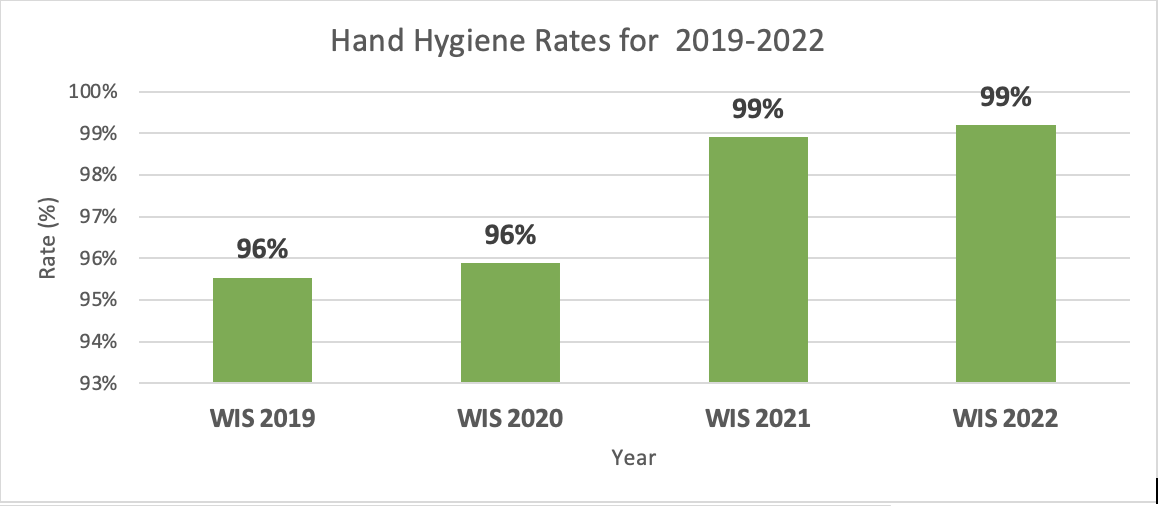
Steps our doctors, nurses, and healthcare personnel in the Women and Infants Center take to promote hand washing:
- Cleanse their hands when they enter and when they exit a patient room
- Wear gloves and cleanse their hands after contact with blood, body fluids, or contaminated surfaces
- Cleanse their hands after removing gloves
- Cleanse their hands before and after invasive procedures
- Monitor compliance regularly to identify any opportunities for improvement
Patient Falls and Injuries
Unexpected patient falls can occur during hospitalization. Serious injuries such as hip fractures can result from a fall. Healthcare personnel in the Women and Infants Center work hard to prevent patient falls and injuries from occurring. Hospitals have standardized protocols to avoid falls and injuries. Hospitals measure the rates of falls and injuries to ensure these practices are followed. Patient falls are reported as a rate of falls per 1000 patient days. A lower rate is better.

Steps our doctors, nurses, and healthcare personnel in the Women and Infants Center take to prevent patient falls and injuries:
- Assess each patient for fall and injury risk
- Provide a fall risk armband to patients as appropriate
- Develop and communicate a safety plan with staff and family members
- Provide patients with easy access to the nurse call light
- Respond promptly when assistance is requested
- Maintain a safe environment free of obstacles
- Provide mobility support devices that meet the patient’s needs
- Monitor fall rates regularly to identify any opportunities for improvement
Hospital Acquired Pressure Injury (HAPI)
Hospital acquired pressure injury (HAPI), also known as pressure injury or bed sores, is an injury to the skin that occurs when there is continual pressure applied to a part of the body. The pressure interferes with blood flow to the area limiting the amount of oxygen and nutrients needed to keep tissue healthy. Pressure injuries commonly occur on the skin that covers bony areas of the body such as the heels, ankles, hips and tailbones. Patients who are bed ridden for long periods are at risk for pressure injuries. Hospitals have standardized protocols to prevent hospital acquired pressure injuries and they measure the rates of hospital acquired pressure injuries to ensure these practices are followed. HAPIs are reported as incidence of pressure injury per 1000 patient days. A lower incidence is better.
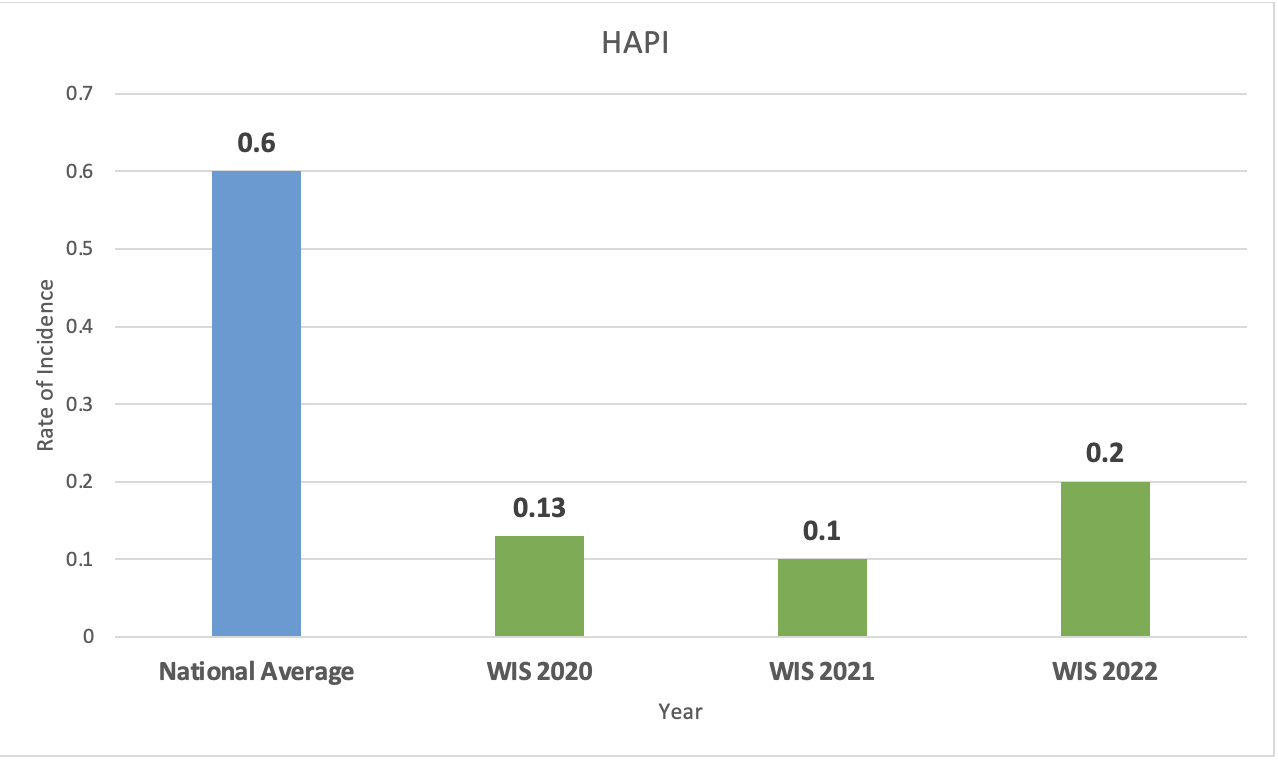
Steps our doctors, nurses, and healthcare personnel in the Women and Infants Center take to prevent a HAPI:
- Assess the patient’s skin on admission and every day for evidence of pressure injuries
- Provide specialized mattresses designed to prevent pressure injuries
- Keep the patient’s skin warm and dry
- Help patients change their position in bed every 2-4 hours
- Use pillows and other products to relieve pressure to an area
- Employ specialized skin and wound care nurses
- Teach nurses the best ways to prevent pressure injuries
- Monitor hospital acquired pressure injury rates regularly to identify any opportunities for improvement